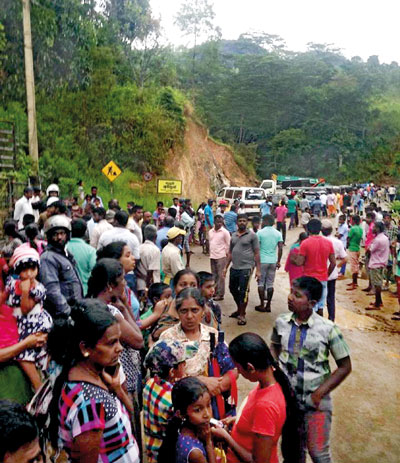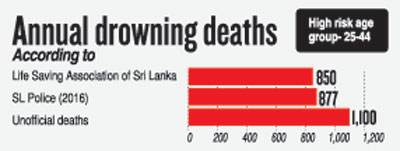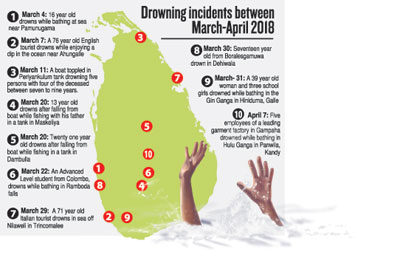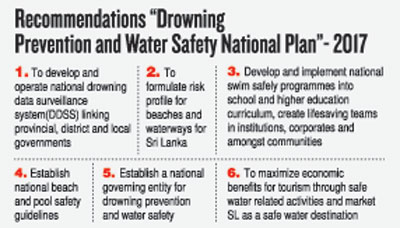News
State apathy continues amid drowning tragedies
Sri Lanka counted yet more deaths – mainly of young people – by drowning in inland rivers and in the ocean in recent months, while the government appears unmoved by the tragedies and is delaying the implementation of a national plan that has been recommended by professionals.

Asanka Nanayakkara, president of the Life Saving Association of Sri Lanka
While the Government lay idle, fate was unkind to several young people early this month.
Sherline Benaz, 26, Madhushan Priyankara, 28, Gajani Sivanathan, 26, Fathima Nusha, 22, and Susil Manjula, 30, who had been on a pre-Avurudu office outing to Kandy on April 7, died by drowning in Dalu Oya in Panwila, Kandy.
The family of Shymali Anoma, 39, of Hiniduma and her 14-year-old daughter Minuli are also grieving their loss by drowning. Minuli’s 14-year-old best friend Ravindi and Kaveesha died in the same incident while bathing in the Gin Ganga in Hiniduma, Galle. Eyewitnesses recall seeing one girl trying to retrieve a box of soap floating away into a deeper part of the river. She had struggled and the other two girls and their mother had attempted a rescue. But they had all perished.
With nearly 1,000 deaths a year, drowning is second only to road traffic accident deaths numbering 3,000-plus in the country.
There were a number of tragedies last month. On March 30, Chamara Roshan, 17, a resident of Boralesgamuwa went missing while enjoying a dip in the ocean close to Auburn Place in Dehiwala.
The same week, Ravindra Kumar, 16, from Ratnapura went missing while bathing in the sea near Pamunugama with friends.
On March 22, Faizul Inshaf, an Advanced Level student from Colombo, drowned in Ramboda Falls. He had been on a holiday to Nuwara Eliya.
Another death was reported in Galkiriyagama, Dambulla where a 21-year-old drowned while fishing in a tank along with two others.
An unfortunate incident was reported on March 11 when an overloaded fishing boat overturned in the Periyankulum tank drowning five, many of them children between seven and nine years old: Dharmalingam Thangathurai, 42, Thangathurai Sangavi, 9, Suresh Kedisraj, 9, Suresh Sudeshan, 7, and Suhadan Piranavi, 9.
On March 20, Wijekumar Thalairama, 13, drowned in a river in Maskeliya, when he fell from the boat he and his father were fishing from.
Not only locals, but tourists, too, often drown in Sri Lanka. A 71-year-old Italian tourist drowned off Nilaveli in Trincomalee on March 29. A 76-year-old English tourist Michael John, drowned while bathing in the sea near Ahungalle.
Asanka Nanayakkara, president of the Life Saving Association of Sri Lanka, said although the official death count annually is about 850, the unofficial toll could be 1,100, since there are instances of missing bodies.
“It is unfortunate that most Sri Lankans do not know to swim despite being surrounded by the ocean and with many rivers, tanks and small waterways,” he said.
He said life savers have qualified trainers and receive support from the Police, Navy lifeguards and the Coast Guard. But, this is mostly volunteer work and there is no government funding.

The most recent tragedy: Crowds gather at Dalu Oya in Panwila where five people drowned. Pic by Chamil Rupasinghe
Mr Nanayakkara said the association works closely with the Disaster Management Ministry, but the group in reality comes under the Sports Ministry.
“The Disaster Management Centre covers 21 disasters but not drowning. There is a need for a state body to be in charge of drowning prevention. We are a volunteer organisation. Programmes like the ‘swim for safety’ is carried out at a slow pace due to costs for logistical arrangements and the availability of swimming pools,” the expert life saver said.
As the death rate is high in the age group of 25-44 years, the lifesavers are planning to extend their training to university students and adults.
Mr Nanayakkara said state schools are reluctant to run awareness programmes on drowning prevention, teach life-saving skills or even offer swimming lessons.
“Education authorities should include swim safety education in the school curriculum and make it compulsory,’’ Mr Nanayakkara said.
He also complained about warning signs that are themselves dangerous.
“Local councils put up signs without consulting, and sometime they do not specify the area that is unsafe. It is essential to get professional life savers whether it is us, police or navy to identify unsafe spots. The Disaster Management Centre should be in charge of putting up warning signs.”
Last year, stakeholders from the Disaster Management Centre, central government and provincial Education Ministries, police and armed forces, Coast Guard, Lifesaving Association, and medical professionals gathered to work towards a national plan for drowning prevention and water safety.
Among the strategies suggested towards the implementation of the plan were to provide swimming and water safety education, communications and manage information for water safety, provide lifesaving and water safety services, conduct water safety research and development, maximise economic benefits for tourism through safe water related activities and to develop regulations for governance of water safety and drowning prevention.
The recommendations were to introduce a national drowning data surveillance system, formulate risk profiles for beaches and waterways of Sri Lanka, develop and implement a national swim for safety programme, establish national beach and pool safety guidelines, set up a national governing entity for drowning prevention and water safety and make the country a safe tourism destination.
Mr Nanayakkara said the state authorities should be willing to implement these recommendations.
Meanwhile, the Coast Guard said 14 towers have been built around the coastal belt. The coast guard lifesavers have rescued 843 people.
Professor Samath Dharmaratne of the Department of Community Medicine at Peradeniya University’s Medical Faculty and an expert in drowning prevention and child injury prevention, said most deaths occur in inland waterways like rivers, tanks and wells.
“Getting into water without any swimming or water safety skill and consuming of alcohol are reasons for drowning deaths among locals. Recent drowning deaths have been caused during rescue attempts. Unless one is thoroughly skilled in swimming and able to swim back dragging a drowning person, it is not recommended to try to save someone as the person drowning will hang on to you,” he advised.
Prof Dharmaratne said that although swimming is considered a sport especially for school students, survival swimming should be encouraged among children as well as adults.
“A national plan on a drowning prevention mechanism
is yet to receive cabinet approval. We plan to
discuss this issue with the President as it is becoming
a concern,” Prof Dharmaratne, said.



